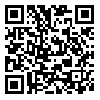Volume 14, Issue 5 (September-October 2015)
Payesh 2015, 14(5): 537-553 |
Back to browse issues page
Download citation:
BibTeX | RIS | EndNote | Medlars | ProCite | Reference Manager | RefWorks
Send citation to:



BibTeX | RIS | EndNote | Medlars | ProCite | Reference Manager | RefWorks
Send citation to:
Jila Sadighi, Ali Hosseini, Kazem Mohammad, Saeed Mahdavi, Siamak Mirab Samieearnaq, Nooshafarin Safadel, et al . Geographical accessibility to medical laboratory services in Iran: modeling population access. Payesh 2015; 14 (5) :537-553
URL: http://payeshjournal.ir/article-1-216-en.html
URL: http://payeshjournal.ir/article-1-216-en.html
Jila Sadighi *1 
 , Ali Hosseini2
, Ali Hosseini2 
 , Kazem Mohammad3
, Kazem Mohammad3 
 , Saeed Mahdavi4
, Saeed Mahdavi4 
 , Siamak Mirab Samieearnaq4
, Siamak Mirab Samieearnaq4 
 , Nooshafarin Safadel4
, Nooshafarin Safadel4 
 , Vahid Banaei5
, Vahid Banaei5 
 , Katayoun Jahangiri1
, Katayoun Jahangiri1 
 , Rahele Rostami1
, Rahele Rostami1 
 , Ziba EslamiNejad6
, Ziba EslamiNejad6 


 , Ali Hosseini2
, Ali Hosseini2 
 , Kazem Mohammad3
, Kazem Mohammad3 
 , Saeed Mahdavi4
, Saeed Mahdavi4 
 , Siamak Mirab Samieearnaq4
, Siamak Mirab Samieearnaq4 
 , Nooshafarin Safadel4
, Nooshafarin Safadel4 
 , Vahid Banaei5
, Vahid Banaei5 
 , Katayoun Jahangiri1
, Katayoun Jahangiri1 
 , Rahele Rostami1
, Rahele Rostami1 
 , Ziba EslamiNejad6
, Ziba EslamiNejad6 

1- Health Metrics Research Center, Iranian Institute for Health Sciences Research, ACECR, Tehran, Iran
2- Department of Geography and Urban Planning, University of Tehran, Tehran, Iran
3- Department of Epidemiology and Biostatistics, Tehran University of Medical Sciences, Tehran, Iran
4- Reference Health Laboratories Research Center, Ministry of Health and Medical Education, Iran
5- Deputy of Architecture & Urban Planning, Ministry of Roads and Urban Development, Iran
6- Bureau of Laboratories, Urmia University of Medical Sciences, Iran
2- Department of Geography and Urban Planning, University of Tehran, Tehran, Iran
3- Department of Epidemiology and Biostatistics, Tehran University of Medical Sciences, Tehran, Iran
4- Reference Health Laboratories Research Center, Ministry of Health and Medical Education, Iran
5- Deputy of Architecture & Urban Planning, Ministry of Roads and Urban Development, Iran
6- Bureau of Laboratories, Urmia University of Medical Sciences, Iran
Abstract: (6331 Views)
Objective (s): Recent advances in health geography lead to more understanding of the role of the geographical distribution and location of health services. In order to reduce the social inequalities, there have been several attempts to measure geographical access to health services. The present study was carried out to assess modeling geographical access to medical laboratory services in Iran.
Methods: The detailed methodology was reported elsewhere. In brief, study units includeded medical laboratories which were active by the end of March 2013 and located within the city borders. A selected number of cities were included in the study. Data were analyzed using experts’ opinions and using Geographic Information System (GIS). In addition, spatial analysis performed using ArcGIS.
Results:This model included two main domains: ‘site selection’ and ‘the number of centers’. The number of centers was dependent upon the urban land use per capita and the site selection consisted of seven elements including population density, distance to service, safety, land use compatibility with neighbors, environmental protection, neighbor to non-constructed land and access to roads.
Conclusion: The proposed model can be fit for selecting sites for medical laboratories in all cities and as well as for locating other medical centers in Iran. However, one should be careful for using the model for site selection in cities with small area. The accuracy of selected sites should be confirmed with field visits and opinions of local experts, because some factors such as economic and legal issues influences the possibility of the usage of proposed lands.
Methods: The detailed methodology was reported elsewhere. In brief, study units includeded medical laboratories which were active by the end of March 2013 and located within the city borders. A selected number of cities were included in the study. Data were analyzed using experts’ opinions and using Geographic Information System (GIS). In addition, spatial analysis performed using ArcGIS.
Results:This model included two main domains: ‘site selection’ and ‘the number of centers’. The number of centers was dependent upon the urban land use per capita and the site selection consisted of seven elements including population density, distance to service, safety, land use compatibility with neighbors, environmental protection, neighbor to non-constructed land and access to roads.
Conclusion: The proposed model can be fit for selecting sites for medical laboratories in all cities and as well as for locating other medical centers in Iran. However, one should be careful for using the model for site selection in cities with small area. The accuracy of selected sites should be confirmed with field visits and opinions of local experts, because some factors such as economic and legal issues influences the possibility of the usage of proposed lands.
Keywords: Medical Laboratory, Geographical accessibility, Urban land use planning, Spatial analysis, Geographical Information Systems (GIS), Iran
type of study: Descriptive |
Accepted: 2015/05/31 | ePublished ahead of print: 2015/08/24 | Published: 2015/08/24
Accepted: 2015/05/31 | ePublished ahead of print: 2015/08/24 | Published: 2015/08/24
| Rights and Permissions | |
 |
This work is licensed under a Creative Commons Attribution-NonCommercial 4.0 International License. |



